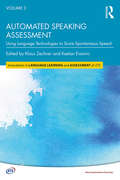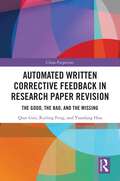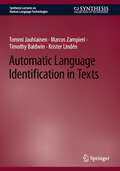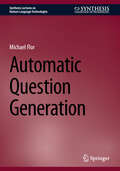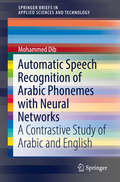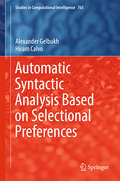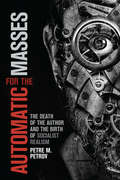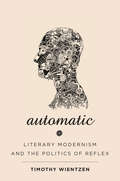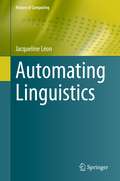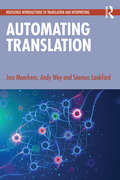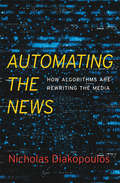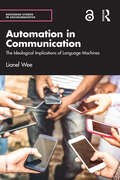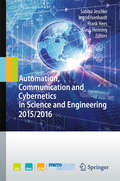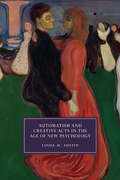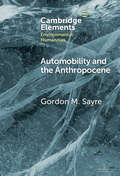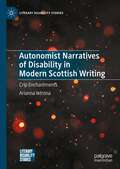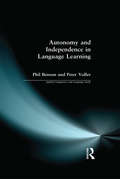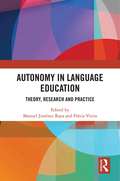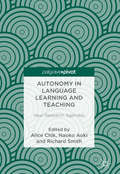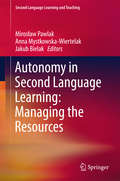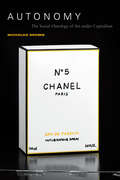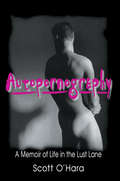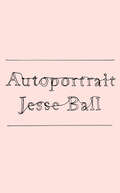- Table View
- List View
Automated Evaluation of Text and Discourse with Coh-Metrix
by Danielle S. McNamara Arthur C. Graesser Philip M. McCarthy Zhiqiang Cai Danielle S. Mcnamara Arthur C. Graesser Philip M. MccarthyCoh-Metrix is among the broadest and most sophisticated automated textual assessment tools available today. Automated Evaluation of Text and Discourse with Coh-Metrix describes this computational tool, as well as the wide range of language and discourse measures it provides. Section I of the book focuses on the theoretical perspectives that led to the development of Coh-Metrix, its measures, and empirical work that has been conducted using this approach. Section II shifts to the practical arena, describing how to use Coh-Metrix and how to analyze, interpret, and describe results. Coh-Metrix opens the door to a new paradigm of research that coordinates studies of language, corpus analysis, computational linguistics, education, and cognitive science. This tool empowers anyone with an interest in text to pursue a wide array of previously unanswerable research questions.
Automated Speaking Assessment: Using Language Technologies to Score Spontaneous Speech
by Klaus Zechner Keelan EvaniniAutomated Speaking Assessment: Using Language Technologies to Score Spontaneous Speech provides a thorough overview of state-of-the-art automated speech scoring technology as it is currently used at Educational Testing Service (ETS). Its main focus is related to the automated scoring of spontaneous speech elicited by TOEFL iBT Speaking section items, but other applications of speech scoring, such as for more predictable spoken responses or responses provided in a dialogic setting, are also discussed. The book begins with an in-depth overview of the nascent field of automated speech scoring—its history, applications, and challenges—followed by a discussion of psychometric considerations for automated speech scoring. The second and third parts discuss the integral main components of an automated speech scoring system as well as the different types of automatically generated measures extracted by the system features related to evaluate the speaking construct of communicative competence as measured defined by the TOEFL iBT Speaking assessment. Finally, the last part of the book touches on more recent developments, such as providing more detailed feedback on test takers’ spoken responses using speech features and scoring of dialogic speech. It concludes with a discussion, summary, and outlook on future developments in this area. Written with minimal technical details for the benefit of non-experts, this book is an ideal resource for graduate students in courses on Language Testing and Assessment as well as teachers and researchers in applied linguistics.
Automated Written Corrective Feedback in Research Paper Revision: The Good, The Bad, and The Missing (China Perspectives)
by Qian Guo Ruiling Feng Yuanfang HuaThis book studies the use of an automated writing evaluation (AWE) systems in research paper revision for publication purposes by Chinese doctoral students.Research writing skills are essential for achieving academic status, and AWE tools can be a great companion on the journey. However, AWE tools may provide a disservice if users do not stay alert to inaccurate feedback, inaccurate correction suggestions, and missed errors. The effects of accurate feedback on revision outcomes have been the focus of a number of AWE studies, but student engagement and revision results in cases of inaccurate feedback and missed errors have rarely been investigated. Such investigations can provide practical advice on using automated feedback in research writing. This book provides a comprehensive evaluation of AWE tools and profiles student engagement with tool use in cases of different qualities of feedback. It can empower novice scholars and improve the effectiveness of academic writing instructors. The findings can also inform AWE system developers about possible ways of system improvement for research paper writing.The book will be particularly useful to students and scholars of language and linguistic studies, education, and academic English writing.
Automatic Language Identification in Texts (Synthesis Lectures on Human Language Technologies)
by Krister Lindén Marcos Zampieri Tommi Jauhiainen Timothy BaldwinThis book provides readers with a brief account of the history of Language Identification (LI) research and a survey of the features and methods most used in LI literature. LI is the problem of determining the language in which a document is written and is a crucial part of many text processing pipelines. The authors use a unified notation to clarify the relationships between common LI methods. The book introduces LI performance evaluation methods and takes a detailed look at LI-related shared tasks. The authors identify open issues and discuss the applications of LI and related tasks and proposes future directions for research in LI.
Automatic Question Generation (Synthesis Lectures on Human Language Technologies)
by Michael FlorThis book provides an overview of the fundamentals of Automatic Question Generation (AQG) for computational linguistics researchers, test developers, and educators. The author presents a variety of AQG system architectures, including generating questions from syntactic analyses, semantic resources, neural architectures, ontologies and knowledge graphs, and large language models. The advantages and pitfalls of a variety of AQG evaluation methods, including multi-aspect ratings by human experts, end-users, as well as crowd-sourcing and automatic evaluation techniques are discussed. The book also provides a roadmap of options for AQG targeted orientation, content selection, and focusing decisions. Machine learning opportunities for training systems to generate questions based on human-generated examples are also explored. This book offers greater depth and breadth than previous surveys of AQG. Readers will gain a comprehensive knowledge of current research, examples of applications of AQG, and inspiration for future directions for innovation and application.
Automatic Speech Recognition of Arabic Phonemes with Neural Networks: A Contrastive Study of Arabic and English (SpringerBriefs in Applied Sciences and Technology)
by Mohammed DibThis book presents a contrastive linguistics study of Arabic and English for the dual purposes of improved language teaching and speech processing of Arabic via spectral analysis and neural networks. Contrastive linguistics is a field of linguistics which aims to compare the linguistic systems of two or more languages in order to ease the tasks of teaching, learning, and translation. The main focus of the present study is to treat the Arabic minimal syllable automatically to facilitate automatic speech processing in Arabic. It represents important reading for language learners and for linguists with an interest in Arabic and computational approaches.
Automatic Syntactic Analysis Based on Selectional Preferences (Studies In Computational Intelligence #765)
by Alexander Gelbukh Hiram CalvoThis book describes effective methods for automatically analyzing a sentence, based on the syntactic and semantic characteristics of the elements that form it. To tackle ambiguities, the authors use selectional preferences (SP), which measure how well two words fit together semantically in a sentence. Today, many disciplines require automatic text analysis based on the syntactic and semantic characteristics of language and as such several techniques for parsing sentences have been proposed. Which is better? In this book the authors begin with simple heuristics before moving on to more complex methods that identify nouns and verbs and then aggregate modifiers, and lastly discuss methods that can handle complex subordinate and relative clauses. During this process, several ambiguities arise. SP are commonly determined on the basis of the association between a pair of words. However, in many cases, SP depend on more words. For example, something (such as grass) may be edible, depending on who is eating it (a cow?). Moreover, things such as popcorn are usually eaten at the movies, and not in a restaurant. The authors deal with these phenomena from different points of view.
Automatic for the Masses
by Petre M. PetrovAt the end of the 1920s, the Modernist and avant-garde artistic programmes of the early Soviet Union were swept away by the rise of Stalinism and the dictates of Socialist Realism. Did this aesthetic transition also constitute a conceptual break, or were there unseen continuities between these two movements? In Automatic for the Masses, Petre M. Petrov offers a novel, theoretically informed account of that transition, tracing those connections through Modernist notions of agency and authorship.Reading the statements and manifestos of the Formalists, Constructivists, and other Soviet avant-garde artists, Petrov argues that Socialist Realism perpetuated in a new form the Modernist "death of the author." In interpreting this symbolic demise, he shows how the official culture of the 1930s can be seen as a perverted realization of modernism's unrealizable project. An insightful and challenging interpretation of the era, Automatic for the Masses will be required reading for those interested in understanding early Soviet culture.
Automatic: Literary Modernism and the Politics of Reflex (Hopkins Studies in Modernism)
by Timothy WientzenA fascinating study of how behavioral science shaped twentieth-century politics and the modernist literary period.The advent of the twentieth century famously brought about new personal and political freedoms, including radical changes in voting rights and expressions of gender and sexuality. Yet writers and cultural critics shared a sense that modern life reduced citizens to automatons capable of interacting with the world in only the most reflexive ways. In Automatic, Timothy Wientzen asks why modernists were deeply anxious about the role of reflexive behaviors—and the susceptibility of bodies to physical stimuli—in the new political structures of the twentieth century. Engaging with historical thinking about human behaviors that fundamentally changed the nature of political and literary practice, Wientzen demonstrates the ways in which a "politics of reflex" came to shape the intellectual and cultural life of the modernist era. Documenting some of the ways that modernist writers and their contemporaries mapped, harnessed, and intervened in a political sphere dominated by conditioned reflexes, Wientzen reads writers like D. H. Lawrence, Rebecca West, Wyndham Lewis, and Samuel Beckett in conversation with fields that include public relations, physiology, sociology, and vitalism. Ultimately, he justifies a reckoning with some of the most enduring preoccupations of modernist studies.Automatic further emphasizes the role of politics and science in the aesthetic projects of modernist writers. At a moment when political enfranchisement and the mass media promised new modes of freedom, agency, and choice, Wientzen argues that the modernist era was beset by apprehension about the conscription of liberty through the conditioning force of everyday life. Analyzing such thinking through a neglected archive about embodiment and reflex reveals modernists responding to the historically novel conditions of political life in the twentieth century—conditions that have become entrenched in the politics of our own century.
Automating Linguistics (History of Computing)
by Jacqueline LéonAutomating Linguistics offers an in-depth study of the history of the mathematisation and automation of the sciences of language. In the wake of the first mathematisation of the 1930s, two waves followed: machine translation in the 1950s and the development of computational linguistics and natural language processing in the 1960s. These waves were pivotal given the work of large computerised corpora in the 1990s and the unprecedented technological development of computers and software.Early machine translation was devised as a war technology originating in the sciences of war, amidst the amalgamate of mathematics, physics, logics, neurosciences, acoustics, and emerging sciences such as cybernetics and information theory. Machine translation was intended to provide mass translations for strategic purposes during the Cold War. Linguistics, in turn, did not belong to the sciences of war, and played a minor role in the pioneering projects of machine translation.Comparing the two trends, the present book reveals how the sciences of language gradually integrated the technologies of computing and software, resulting in the second-wave mathematisation of the study of language, which may be called mathematisation-automation. The integration took on various shapes contingent upon cultural and linguistic traditions (USA, ex-USSR, Great Britain and France). By contrast, working with large corpora in the 1990s, though enabled by unprecedented development of computing and software, was primarily a continuation of traditional approaches in the sciences of language sciences, such as the study of spoken and written texts, lexicography, and statistical studies of vocabulary.
Automating Translation (Routledge Introductions to Translation and Interpreting)
by Joss Moorkens Andy Way Séamus LankfordTranslation technology is essential for translation students, practising translators, and those working as part of the language services industry, but looming above others are the tools for automating translation: machine translation and, more recently, generative AI based on large language models (LLMs).This book, authored by leading experts, demystifies machine translation, explaining its origins, its training data, how neural machine translation and LLMs work, how to measure their quality, how translators interact with contemporary systems for automating translation, and how readers can build their own machine translation or LLM. In later chapters, the scope of the book expands to look more broadly at translation automation in audiovisual translation and localisation. Importantly, the book also examines the sociotechnical context, focusing on ethics and sustainability. Enhanced with activities, further reading and resource links, including online support material on the Routledge Translation studies portal, this is an essential textbook for students of translation studies, trainee and practising translators, and users of MT and multilingual LLMs.
Automating the News: How Algorithms Are Rewriting the Media
by Nicholas DiakopoulosFrom hidden connections in big data to bots spreading fake news, journalism is increasingly computer-generated. Nicholas Diakopoulos explains the present and future of a world in which algorithms have changed how the news is created, disseminated, and received, and he shows why journalists—and their values—are at little risk of being replaced.
Automation in Communication: The Ideological Implications of Language Machines (Routledge Studies in Sociolinguistics)
by Lionel WeeBy drawing on multiple examples from healthcare, religion, service encounters and poetry, Lionel Wee presents rich insights into the use of automation in communication through a posthumanist lens. As communication becomes increasingly automated, the use of automation creates significant conceptual challenges for ideologies about language, beliefs about the nature of language, as well as assumptions about the roles that interpretation, anthropomorphism, and folk theories of mind play when language is used in communication. This book unravels the ideological implications of automation in communication and provides a new theoretical ground to address the major issues raised by automation. Wee discusses the importance of thinking carefully about how we identify and distinguish the roles of speaker and hearer. He also argues that we re-evaluate our understanding of the relationship between language and community.This book will be vital to students interested in studying the intersections of AI, language and communication, as well as researchers working in communication studies, linguistics and the broader sociology of language in the age of technological change.
Automation, Communication and Cybernetics in Science and Engineering 2015/2016
by Sabina Jeschke Ingrid Isenhardt Frank Hees Klaus HenningAutomation, Communication and Cybernetics in Science and Engineering 2015/2016
Automatism and Creative Acts in the Age of New Psychology (Cambridge Studies In Nineteenth-century Literature And Culture Ser. #111)
by Linda M. AustinThe late nineteenth century saw a re-examination of artistic creativity in response to questions surrounding the relation between human beings and automata. These questions arose from findings in the 'new psychology', physiological research that diminished the primacy of mind and viewed human action as neurological and systemic. Concentrating on British and continental culture from 1870 to 1911, this unique study explores ways in which the idea of automatism helped shape ballet, art photography, literature, and professional writing. Drawing on documents including novels and travel essays, Linda M. Austin finds a link between efforts to establish standards of artistic practice and challenges to the idea of human exceptionalism. Austin presents each artistic discipline as an example of the same process: creation that should be intended, but involving actions that evade mental control. This study considers how late nineteenth-century literature and arts tackled the scientific question, 'Are we automata?'
Automobility and the Anthropocene: The Car as Post-Human (Elements in Environmental Humanities)
by Gordon M. SayreThe automobile has transformed Earth's habitats and humans' habits since the 1890s, when it, this Element argues, began the Anthropocene. Climate change now motivates efforts to reduce greenhouse gas emissions, of which cars and trucks account for at least 10 percent. Shifting to electric vehicles is not enough; one needs to better understand the power cars hold over humans. Environmental humanities scholars examine human/machine hybrids but have ignored the most obvious example. Humans driving cars are social agents constituting a civil society of automobility in roadscape environments. This Element traces the evolution of cars from horsecars, carriages, and bicycles, and the influence of Henry Ford and Alfred P. Sloan on labor standards and consumer behaviors. As the car industry pushes high-tech autonomous or self-driving vehicles, it relies on futuristic fantasies and false promises. The ills of automobility cannot be solved with new products that only intensify human dependence upon cars.
Autonomist Narratives of Disability in Modern Scottish Writing: Crip Enchantments (Literary Disability Studies)
by Arianna IntronaAutonomist Narratives of Disability in Modern Scottish Writing: Crip Enchantments explores the intersection between imaginaries of disability and representations of work, welfare and the nation in twentieth and twenty-first century Scottish literature. Disorienting effects erupt when non-normative bodies and minds clash with the structures of capitalist normalcy. This book brings into conversation Scottish studies, disability studies and Marxist autonomist theory to trace the ways in which these “crip enchantments” are imagined in modern Scottish writing, and the “autonomist” narratives of disability by which they are evoked.
Autonomy and Independence in Language Learning (Applied Linguistics and Language Study)
by Phil Benson Peter VollerThe topics of autonomy and independence play an increasingly important role in language education. They raise issues such as learners' responsibility for their own learning, and their right to determine the direction of their own learning, the skills which can be learned and applied in self-directed learning and capacity for independent learning and the extents to which this can be suppressed by institutional education.This volume offers new insights into the principles of autonomy and independence and the practices associated with them focusing on the area of EFL teaching. The editors' introduction provides the context and outlines the main issues involved in autonomy and independence. Later chapters discuss the social and political implications of autonomy and independence and their effects on educational structures. The consequences for the design of learner-centred materials and methods is discussed, together with an exploration of the practical ways of implementing autonomy and independence in language teaching and learning . Each section of the book opens with an introduction to give structure to the development of ideas and themes, with synopses to highlight salient features in the text and help build upon the material of previous chapters.
Autonomy in Language Education: Theory, Research and Practice
by Manuel Jimenez Raya Flavia VieiraAutonomy in Language Education offers a holistic overview of and novel contribution to a complex and multifaceted, yet under-studied, field of inquiry that is transforming language pedagogy: It offers nineteen original chapters that critically analyze the impact of Henri Holec’s seminal 1979 book Autonomy in Foreign Language Learning; unpack theoretical, empirical, conceptual, methodological, ethical, and political developments over the last forty years from many perspectives; explore practical implications for teaching, learning, and teacher education; and suggest future avenues and challenges for research and practice in this broad, diverse, essential field.
Autonomy in Language Learning and Teaching: New Research Agendas
by Richard Smith Alice Chik Naoko AokiThis book seeks to expand the research agendas on autonomy in language learning and teaching in diverse contexts, by examining the present landscape of established studies, identifying research gaps and providing practical future research directions. Based on empirical studies, it explores research agendas in five emerging domains: language learning and teaching in developing countries; social censure and teacher autonomy; learner autonomy and groups; learner autonomy and digital practice; and finally, learner autonomy and space. In doing so, it sheds new light on the impact of digital media, group dynamics and the application of ecological perspectives on learner autonomy. The contributors present a novel reconsideration of new learning affordances, and their discussion of spatial dimensions provides much needed expansion in the field. This book will have international appeal and provide an invaluable resource for students and scholars of second language learning and higher education, as well as teacher educators. Chapter 2 of this book is open access under a CC BY 4. 0 license via link. springer. com.
Autonomy in Second Language Learning: Managing the Resources (Second Language Learning and Teaching)
by Mirosław Pawlak Anna Mystkowska-Wiertelak Jakub BielakThe present volume brings together papers devoted to the role of learner and teacher autonomy in the process of second and foreign language learning, which have been contributed by scholars from Poland and abroad. The book has been divided into three parts in accordance with the topics that the individual contributions touch upon. The first chapter includes papers dealing with different ways in which learner autonomy can be fostered and evaluated. Chapter Two focuses on developing teacher autonomy, which, in the opinion of many specialists, is indispensable if learner autonomy is to be promoted. Finally, the papers contained in Chapter Three are connected with the role of language learning strategies in the development of learner independence. Thanks to its wide-ranging focus, this edited collection will be of interest not only to second language learning specialists interested in the role of learner autonomy, but also to undergraduate, graduate and postgraduate students working on their BA, MA and PhD theses, as well as practitioners wishing to promote learner independence in their classrooms.
Autonomy, Agency, and Identity in Teaching and Learning English as a Foreign Language
by Mark Feng TengThis book discusses the importance of autonomy, agency, and identity in teaching and learning English as a foreign language, all of which are central themes in the educational domain. By linking theory with practice to appeal to researchers as well as classroom practitioners, it provides an overview of the theoretical constructs of autonomy, agency, and identity along with empirical studies that explore these constructs through life stories as told by English teachers and students. Key features include: • New ideas to inspire professionals involved in foreign language education. • Up-to-date information to showcase for English language educators how autonomy, agency, and identity can be conceptualized across various institutional, sociocultural, and political contexts.• A concise yet comprehensive review of the theoretical and practical issues characterizing English foreign language education today.
Autonomy: The Social Ontology of Art under Capitalism
by Nicholas BrownIn Autonomy Nicholas Brown theorizes the historical and theoretical argument for art's autonomy from its acknowledged character as a commodity. Refusing the position that the distinction between art and the commodity has collapsed, Brown demonstrates how art can, in confronting its material determinations, suspend the logic of capital by demanding interpretive attention. He applies his readings of Marx, Hegel, Adorno, and Jameson to a range of literature, photography, music, television, and sculpture, from Cindy Sherman's photography and the novels of Ben Lerner and Jennifer Egan to The Wire and the music of the White Stripes. He demonstrates that through their attention and commitment to form, such artists turn aside the determination posed by the demand of the market, thereby defeating the foreclosure of meaning entailed in commodification. In so doing, he offers a new theory of art that prompts a rethinking of the relationship between art, critical theory, and capitalism.
Autopornography: A Memoir of Life in the Lust Lane
by Scott O' HaraIn this provocative book, retired porn star Scott O’Hara (known as “Spunk” by many of his fans from an early punk photospread) gives a backstage look at the world of pornography, revealing why he loved it, what he got out of it, and why he left it. In an autobiographical style, he considers and poses answers to some fascinating questions: What is sex? What makes a porn star? And why does pornography really upset people? You’ll really get to know this noted gay porn star as you get a firsthand look at his life experiences and sexual journeys from his boyhood days of locker room fantasies and sexual experimentation to his years as a porn star and then to his experiences as an individual facing the realities of being HIV-positive. As O’Hara puts it in his Introduction: “This book was written as a last-ditch effort: a way to open up all my closets, let you in on all the dark corners of my life, and give you a better picture of what goes into the making of a porn star. Because if there’s one profession that arouses people’s curiosity, it’s that one.” As you read through the pages of Autopornography, you’ll see how O’Hara’s personality reflects his sexuality, that is, how they have melded into one. His vivid descriptions of personal relationships (with family, friends, lovers, and casual acquaintances) and his many sexual encounters as he traveled the world reveal his love of sex and his desire to live without inhibitions, secrets, or sexual constraints. Reading Autopornography may cause you to reexamine your own sexual boundaries, realize new sexual potential, and discover sexual desires not previously aroused.Listed #14 on Books Bought Mainly by Men 1997 Top 100 Bestsellers as rated by A Different Light Bookstore!
Autoportrait
by Jesse BallA work of unflinching honesty, Autoportrait is a hypnotic memoir of reflection, loss, and everyday joy from one of America's best contemporary novelistsJesse Ball has produced fourteen acclaimed works of deeply empathetic absurdism in poetry and fiction. Now, he offers readers his first memoir, one that showcases his &“humane curiosity&” (James Wood) and invites the reader into a raw and personal account of love, grief, and memory. Inspired by the memoir Édouard Levé put to paper shortly before his death, Autoportrait is an extraordinarily frank and intimate work from one of America's most brilliant young authors.The subtle power of Ball's voice conjures the richness of everyday life. On each page, half-remembered moments are woven together with the joys and triumphs—and the mistakes and humiliations, too—that somehow tell us who we are, why we are here. Held at the same height as tragic accounts of illness or death are moments of startling beauty, banality, or humor: "I wake in the morning, I sit, I walk long distances. If there is somewhere to swim, I may swim. If I have a bicycle, I will ride it, especially to meet someone. There is no more preparing for me to do, other than preparing for death, and I do that by laughing. Not laughing at death, of course. Laughing at myself." An extraordinary memoir that reminds us what is possible and builds to the kind of power one might feel reading Anne Carson's Glass Essay, or Joe Brainard's I Remember. Autoportrait will leave you feeling utterly invigorated, inspired, and a little afraid.

